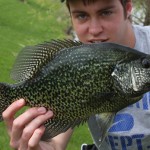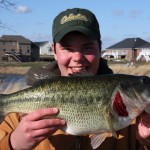By: Tony Boshold and Ted Pilgrim – Date Posted: January 20, 2011
Ice fishing tournament ace Tony Boshold sweeps through jungles of panfish plants like a carpet cleaner. Proprietor of a highly successful, professional steam cleaning business, Boshold vacuums the flats with an ice auger, long rod, and box of his favorite little jigs.
Having won on ice angling’s grandest stages, including the 2010 World Ice Fishing Championship and 2005 NAIFC National Championship, Boshold approaches every competitive event with never-ending enthusiasm. Always ahead of the crowd, the Chicago native tracks down pods of heavyweight bluegills and crappies as if they were little pots of gold. Nobody’s better, either, when it comes to sniffing out hot leads during pre-event sleuthing.
“First thing I always do to scout a new tournament location is gather up as many lake maps as I can find,” says the captain of ‘Team Prowler.’ “Not all of our tournament lakes have been mapped by LakeMaster, so I’m often looking for any map I can find—sometimes it’s an old DNR survey chart, other times, it’s a secret homemade lakemap drawn up in a dimly lit backroom at the baitshop. Sometimes it almost takes a secret code to gain access to it.
“The other thing I’ll do is dial up the lake using a satellite application like Google Earth. I want to see what the water clarity looks like; check for locations of weedbeds, rockpiles, major points—a lot of this stuff can be easily seen on a good aerial photograph.”
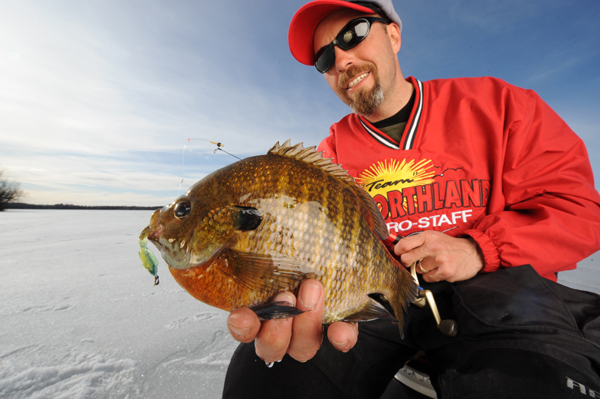
Secret Maps
Another sweet tool, Boshold says, is a mapping tool called Electronic Guide Service (electronicguideservice.com). “More and more competitors are discovering the advantages of having not only a digital lakemap in their GPS, but also a cache of key waypoints. For example, their mapping product of Boom Lake, Wisconsin gives you both detailed depth contours and 546 coordinates that show precise spots—39 verified sunken crib locations, as well as logs, stumps and rockpiles, hot vegetation zones, and even the known haunts of significant schools of fish.
“You get a file that you can download right into your GPS, giving you immediate access to information that would take years to compile yourself. Really, it’s just an awesome tool that saves us time in tournaments.”
Another resource for pre-tournament scouting, Boshold says, are state departments of natural resources. “As soon as tournament sites are announced, I want to be the first guy to call the biologists, as well as the creel surveyors. Lots of times, I won’t tell them I’m fishing a tournament. If I come off like average Joe, they’re much more open with information on fisheries. Often, too, it’s the creel clerks who have intimate knowledge of where fish are caught, because they’re out there gathering real fishing data from anglers. They can tell you what’s being caught where, as well as when and with what presentations.”
Which leads Boshold to his initial scouting missions on the ice. “On any lake, the first thing I do is head straight for the biggest shanty-town (area with all the permanent and portable shelters). I hang around and talk shop with different fishermen. I might poke my MarCum camera down a few holes to get the lay of the land—look for available vegetation or fish. I also want to be there at dawn and dusk; need to determine when the peak bites are occurring. That’s the time when all the 4-wheelers and portables start showing up on the spot. I make note of this, so we can duplicate the pattern in other less crowded areas around the lake.
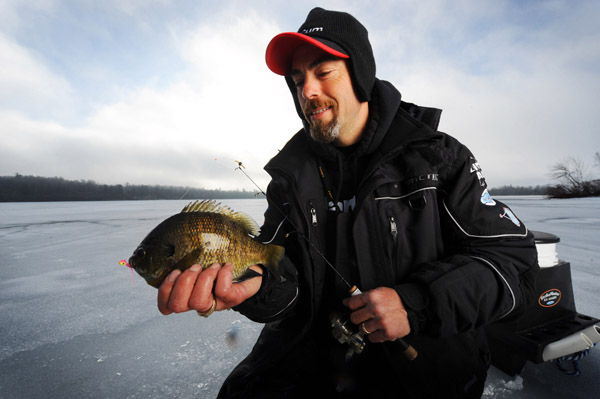
“At the same time, my partner might be doing the same recognizance on another part of the lake. We’ll eventually meet up and compare notes. We’ll spread a lakemap on a big table and start penciling things in. We’ll rank spots by potential. Then we’ll divide ‘em up and go our separate way again; we can cover a lot more ground by splitting up than we can by going everywhere together. I’ll grab my StrikeMaster Laser Pro and MarCum camera, and Mike (McNett) will take his stuff, including his ShowDown Ice Troller.
“We’ll each be drilling and doing a lot of survey and camera work—maybe for an entire day before any fishing occurs. I’m always taking notes on the details—ice thickness, snow cover, fish size (I might catch and weigh a few bluegills or crappies), vegetation or other cover, and water temperature. My MarCum VS825SD camera has an on-screen water temp function that helps me pattern fish. Anytime I find a concentration, I’ll note the temp and try to find other areas hosting that same temperature. It can be a real key.”
Regarding drilling, Boshold says that it’s best, if possible, not to Swiss cheese an area anymore than necessary, which prevents others from uncovering his spots. “I want to look as bored as I can during prefishing,” Boshold continues. “No matter how many fish I’m seeing, I don’t stop looking for very long. Other competitors are always watching. I never want to give the impression that I’ve stumbled across anything good, no matter how excited I might be at unearthing the mother lode. Also, I never erase my GPS ‘track’ after a day, because you never know when a new snow will move through and erase my holes. The GPS track function keeps me on good water all the time.”
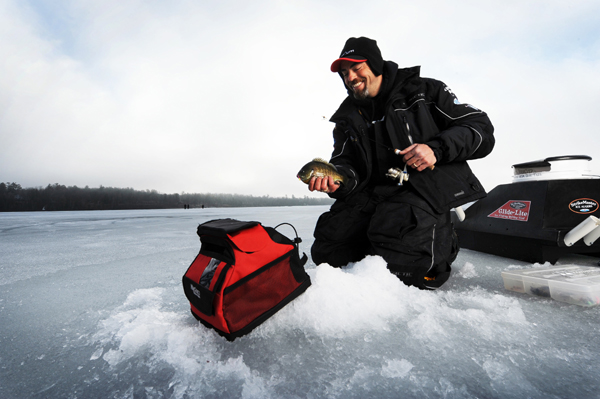
Coldfront Factoring
Of course, even one of Boshold’s panfish “mother lodes” can quickly turn sour, given the arrival of a nasty winter cold front. But there’s an answer: “Just about every three days, you can rely on a front moving through,” Boshold observes. “What happens in prefishing is that most guys show up a few days before the event, find good fish, and then, on tournament day, the front moves in and they’re out of business.
“I like to arrive when the previous front rolls through. If I can prefish through a front—before tournament day—I get to sample what happens to the bite; can see how fish react and move, during the bad conditions. If I can figure anything out at all during and after a front—even if I just barely eek out a limit— then that puts me way ahead of my competitors on tournament day, which always seems to coincide with the next front.
Beyond Boshold’s slick trickery and occasional sleight-of-hand, there’s a real method to his tournament fishing madness. “Lots of times,” he states, “my partner and I simply drill more holes—cover more water—than anyone else. Along these lines, we do a lot of fishing while standing up, which keeps us on the move. With the new generation of winter wear, especially my Frabill FXE SnoSuit, I can stay warm all day long, right out in the elements. I like a long rod, too, such as a 36- to 42-inch St. Croix Legend or Frabill Ice Hunter. I can keep the rodtip close to the ice to avoid freeze-up, and I can dip my jigs and pull fish out of shallow water quick, without even turning the reel handle. A long rod also lets me move to various holes all around my standing position, without doing more than shuffling my feet. Hugely efficient, especially when panfish pack into tight quarters.”
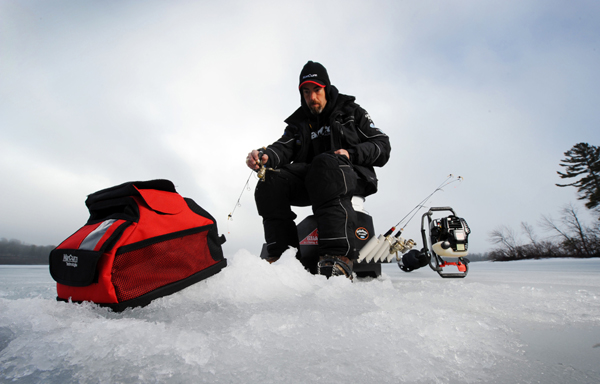
On the business end of things, Boshold remains steadfast on jig selection, although even here, he wanders from the crowd. “My favorite approach is to go ‘vertizontal,’” he quips, with a sly grin. “I’ll often tie up a vertical jig, such as a Northland Live Forage Minnow Jig or Little Atom Shmoe, and then dress the hook with a micro plastic bait rigged horizontally. When you rig a vertical jig this way, it swims to the side on the drop. When you engage the bail and stop its decent, the combo pendulums and swings back toward center, which triggers big panfish like no other motion I’ve found.”
Boshold says that despite reluctance from many anglers, plastics like his favorite Northland Bloodworm and Little Atom Nuggies select for the biggest bluegills and crappies available. “Small fish might just nudge and sniff ‘em, but the bigger specimens absolutely gobble these baits up.”
For Boshold, everything fits neatly into his continually evolving system. “The tools we use in tournaments must, by necessity, match our fast, efficient approach to fishing. Our Frabill Recon shelters hold gear and serve as primary fishing stations, while my custom-rigged StrikeMaster Glide Lite sled can quickly mobilize into a run-and-gun console on the ice. It holds a brace of prerigged rod-reel combos, a 5-gallon bucket, as well as bait, tackle, MarCum LX-5 flasher and an underwater camera. I’ve even mounted Bait Pucks right on the sled, so bait and plastics are always within reach.” Indeed, with the 2011 NAIFC tournament season at hand, fellow anglers take note, visions of palm-stretching panfish are dancing in Boshold’s head, even as we speak.
Tony Boshold can be visited online at www.tonybosholdfishing.com



